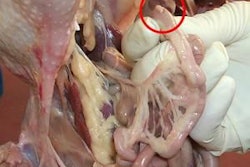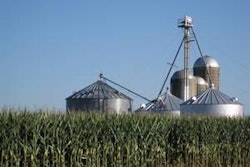
Vietnam’s feed market in 2009 has presented several examples of investment to start a new plant or expand the manufacturing capacity of an existing site. But it has also demonstrated the adverse effects of a credit crunch. With borrowing suddenly more difficult and more expensive, some of the newer mills have found that their business plans were rather too optimistic.
As one Vietnamese industry insider remarked to Feed International at the end of last year, the problem of financing has been felt more by operations in the small to medium category for size than by the bigger players. Enterprises large and small could capitalise the land, shell and equipment for a new mill, but newcomers and those with only low volumes struggled to borrow the money needed for operating capital.
Fatal weakness
For some of them it was a fatal weakness, bearing in mind that the money for purchases of raw materials and for underwriting the credit terms on sales over the course of a year could often prove to be five times what they had paid to build their mill. Just as Vietnam in 2009 saw the commissioning or opening of several additional feed plants, therefore, it also witnessed the closure of other mills whose owners and investors failed to find the necessary finance.
Commentators within Vietnam agree that the events of 2009 will fuel the longer term trend to consolidation in the national feed sector. A common view is that big companies can even exploit the credit crunch to consolidate their own position at a difficult time, while their more exposed competitors retrench or disappear.
A report in 2009 from Singapore-based market analysts Stanton, Emms & Sia suggested that about 40% of all feed manufacturers in Vietnam were experiencing operational difficulties in the early months of last year. Half of these were either insolvent or had been obliged to close their operation, at least temporarily. The root of the problem for many had been the forward buying of ingredients before feed grain prices tumbled in the later part of 2008. They had also, said the analysts, been hit by a drop in the export demand for Vietnamese fish and seafood.
At the start of the decade the MARD governmental department responsible for agricultural and rural development was reporting the industrial feed sector nationally to consist of 110 mills with a total production capacity of 3.5 million metric tons per year. Also according to MARD, these plants between them produced almost 2 million metric tons of feeds in 2000 and 2.7 million metric tons in 2002.
By 2006 the national data showed 203 feed mills with a combined annual output of about 7 million metric tons. An official assessment only 12 months later reported 241 plants. That number has kept increasing so that the 2009 roster contained 314 feed manufacturers and their total production amounted to around 8 million metric tons.
Many of the companies are subsidiaries of foreign corporations. Recently, a Vietnamese government report described foreign ownership as being involved in almost 15% of all mills nationally. Our own list of the biggest players (see Table 1) illustrates this point well. Only GreenFeed of the top nine manufacturers listed has entirely local owners. CP is linked to the Thai conglomerate of the same name, Proconco had French shareholders in the past although now 60% are Vietnamese with the other 40% in foreign funds. Cargill’s parent is American. Asia Nutrition Technologies (ANT) is from Taiwan. New Hope and East Hope originate in China. Japfa has its headquarters in Indonesia. Evialis/Guyomarc’h is from France. Also represented on the list are CJ (Korea), UniPresident (Taiwan) and San Miguel (Philippines).
Foreign backers predominated
Foreign backers have predominated in feed deals nationally during 2009. The trend for the year was set with the formation of De Heus Vietnam by De Heus International of the Netherlands, from its purchase of local manufacturers Indochine Feeds (located north of Ho Chi Minh City) and PG Richfarm (based in Haiphong). CP Vietnam Livestock Co is establishing a fishfeed plant in the southern province of Ben Tre and an integrated feed+poultry venture near Ho Chi Minh City. Vina Aquafeed opened a mill in the Mekong Delta to join its two existing plants nationwide. ANT announced plans to build more mills in Vietnam while estimating a 30% growth to 120,000 metric tons per year for output from its three sites in Long An, Hanoi and Dong Nai in 2009. Cargill's sixth feed mill in Vietnam was opened at the end of last year to make aqua diets in the Mekong Delta province of Dong Thap.
It is no surprise that several of these projects aim to produce feeds for aquaculture. Vietnam’s total production of aquafeeds has been rising rapidly, reaching 1.5 million metric tons in 2007 and achieving an estimated 2.4 million metric tons in 2009 (see Table 2). Again this part of the market is a mix of foreign ownership and increasing consolidation. Looking only at feeds for tilapia and pangasius, the production capacity of the seven largest players is now put at approximately 2 million metric tons out of a total for all factories of 3 million metric tons/year.
However, the aquaculture business in Vietnam suffered in 2009 from a combination of depressed demand, low fish prices and relatively costly feed ingredients. Animal feed sales remained strong by contrast, apparently not too much affected by a series of disease outbreaks. The operations manager of a major Vietnamese feed company has told us that it registered a sales growth as high as 34% in its southern sector last year and this was mainly for pigs.
In good position to benefit
About 40% of all pigs in Vietnam are on farms within the delta zones of the Mekong and Red rivers. These areas also account for over 40% of all feed production nationally. Their mills are in a good position to benefit from the expanded market that is forecast up to 2015, in which the national output of pork and poultrymeat are predicted to rise to 4.35 million metric tons and 880,000 metric tons per year respectively.
The Ministry of Agriculture and Rural Development (MARD) has said it expects Vietnam’s total feed requirements to increase by more than 8% in the coming 10 years, in support of plans to encourage animal industries so that their share of annual agricultural revenues rises from around 24% to 42%. It will invest in new technology to ensure the quality for processing of materials.
However, the problems in meeting this extra demand will involve finding the necessary ingredients as well as providing the extra manufacturing capacity. The average growth rate for national feed production of 10% per year achieved over the past decade has hardly altered a heavy reliance on imported ingredients and blends. By most estimates the supply from Vietnam’s feedingstuff producers still does not satisfy more than 70% of the amount needed, leaving around 4 million metric tons per year of soybean meal, corn and other materials to be brought in at a cost that reached US$2 billion in 2008.
Today the total requirement – covering all materials – is reckoned to be between 12-13 million metric tons per year. MARD predicts a growth up to 18-19 million metric tons by 2021. While there may be some success at providing more of the ingredients from local sources, industry insiders say this is likely to be limited. They point to a shortage of good facilities for drying and storing newly harvested grain as a major difficulty.
Locally grown crops
Locally grown crops at present are seen as supplying perhaps 3-4 million tons of maize, even if it is of poor quality, alongside a similar quantity of rice bran and between 2.5-3 million metric tons of cassava. The rest will have to come from imports, necessitating feed manufacturers to become involved in forward buying at variable exchange rates. This is likely to be another instance, say commentators locally, where the smaller players suffer and the big ones exploit their scale advantage.

















